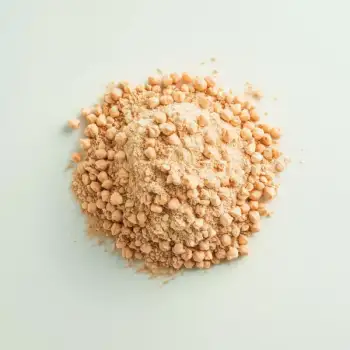Chickpea Flour and All Purpose Flour are two distinct types of flour used in cooking and baking. Chickpea Flour is a gluten-free, protein-rich option with a nutty flavor, ideal for heartier dishes. All Purpose Flour is a versatile, neutral-tasting flour suitable for a wide range of recipes.

Also known as gram flour or besan, chickpea flour is a gluten-free flour made from ground chickpeas. Its rich, nutty flavor and dense texture make it a popular choice in many cultures, particularly in Indian, Middle Eastern, and Mediterranean cuisines.

All purpose flour is a wheat flour that has been refined to remove the bran and germ, leaving mostly the endosperm. It's a versatile flour with a relatively neutral taste, making it a staple in baking and cooking across various cuisines.
Chickpea flour is gluten-free, has a higher protein content, and offers a distinct nutty flavor compared to the mild and versatile all purpose flour. The texture of chickpea flour is denser and coarser, while all purpose flour is finer and better suited for achieving lighter, fluffier textures in baked goods.

Your ultimate Recipe Box, Meal Planner, and Cooking Class all in one
Ideal for savory pancakes, fritters, and socca. Expect a hearty, protein-rich batter that browns beautifully with a robust flavor. For a lighter texture, mix with other gluten-free flours. Perfect for crepes, waffles, and classic pancakes. It creates a smooth, flexible batter for light and airy results. To enrich flavor, it can be combined with whole grain flours.
Use in gluten-free bread, muffins, and cookies for added protein and fiber. The end product will have a denser texture, so it is often mixed with other gluten-free flours to improve consistency. Not suitable for gluten-free baking on its own, but can be replaced with gluten-free all purpose flour blends for similar results without gluten.
Acts as a thickener in soups and sauces, imparting a slight bean-like flavor. Start with a small amount to avoid overpowering the dish. A traditional roux base for thickening sauces and gravies, with a neutral taste that won't alter the flavor profile of the dish.
Provides a unique, crispy coating for vegetables or proteins when used for breading. It may also be used in batter recipes for a gluten-free option. The classic choice for a light, crunchy breading or batter, such as for fried chicken, tempura, or onion rings. It adheres well and fries to a golden brown.
Chickpea flour is higher in protein, fiber, and nutrients compared to all purpose flour, and is gluten-free, making it suitable for those with gluten sensitivities.
| Nutrient | Chickpea Flour ( per 100g ) | All Purpose Flour ( per 100g ) |
|---|---|---|
| Fat | 7g | 1g |
| Iron | 4.86mg | 4.64mg |
| Fiber | 11g | 3g |
| Calcium | 45mg | 15mg |
| Protein | 22g | 10g |
| Calories | 387 | 364 |
| Carbohydrates | 58g | 76g |
Chickpea flour can replace all purpose flour in some recipes, especially for gluten-free baking, but it will affect the taste and texture. It's not recommended for recipes that rely on gluten, such as yeast breads.
Chickpea flour is often considered healthier due to its higher protein, fiber, and nutrient content, as well as being gluten-free.
Chickpea flour imparts a nutty, slightly bean-like flavor that can enhance savory dishes but may be noticeable in sweet baked goods.
No, all purpose flour contains gluten and should not be used in gluten-free recipes. However, there are gluten-free all purpose flour blends available as substitutes.
Chickpea flour should be stored in a cool, dry place or refrigerated to extend its shelf life due to its higher oil content. All purpose flour can be stored at room temperature in an airtight container.